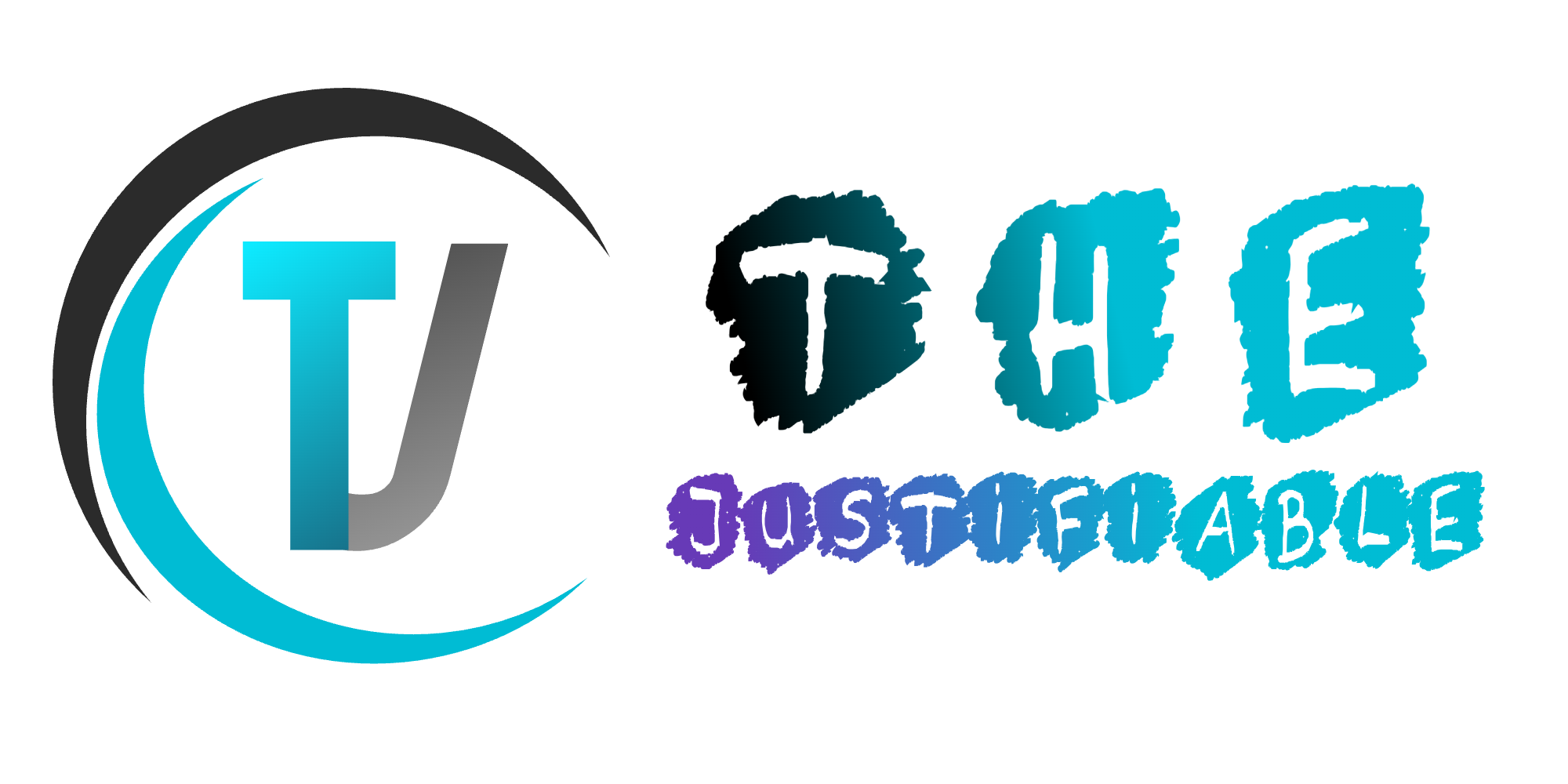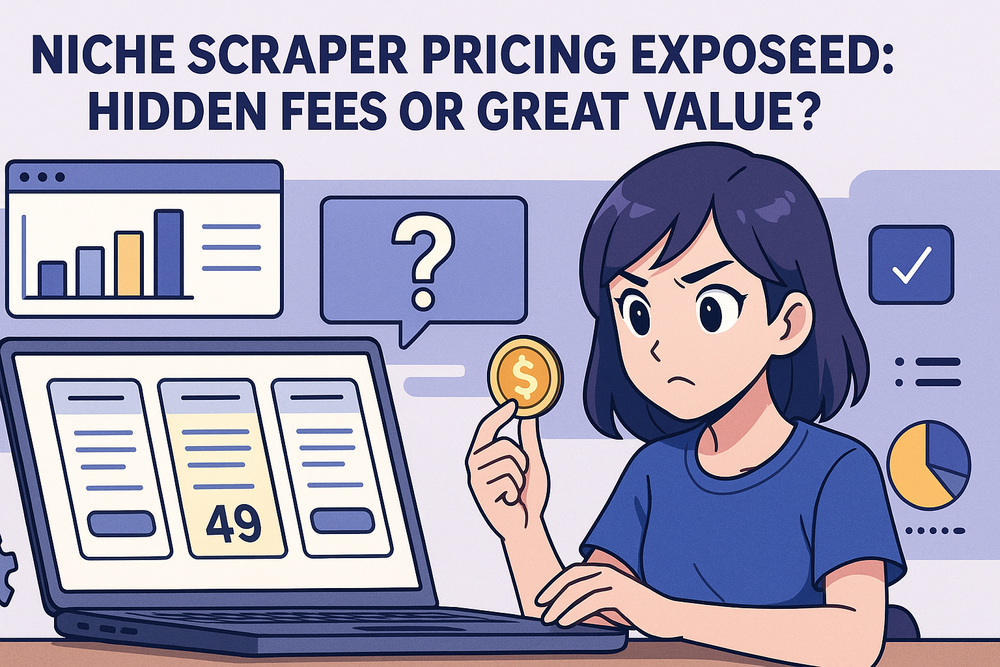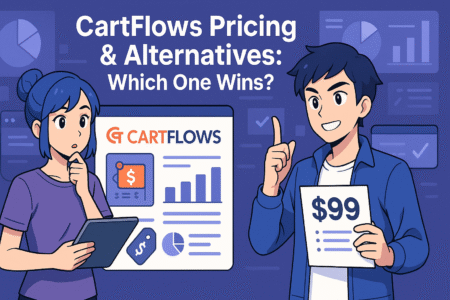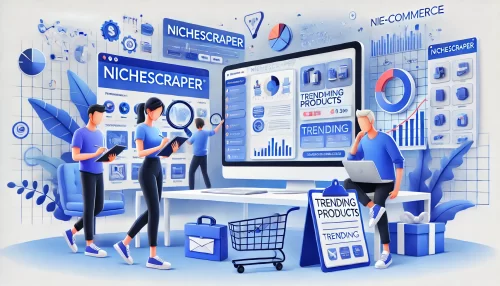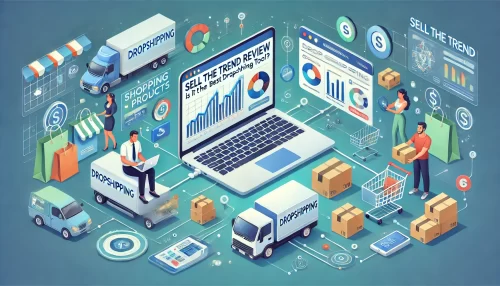Table of Contents
Is niche scraper pricing really as straightforward as it seems? Or are there hidden fees and limitations that could catch you off guard once you sign up?
If you’re considering Niche Scraper to help with product research or launching your dropshipping store, it’s smart to look beyond the sales page. You might be wondering if the tool actually delivers on its promises, or if you’d be better off investing in something else entirely.
In this article, we’ll unpack what you’re really getting for your money, how it compares to other tools, and whether it’s worth upgrading—or canceling altogether. Let’s dive in and find out if it’s great value or a costly surprise.
Understand What’s Included in Niche Scraper Pricing Plans
Before committing to a paid tool, you should know exactly what you’re paying for. Niche Scraper pricing isn’t overly complicated, but the value you get can depend a lot on how you plan to use the platform.
Explore the Free Version and What It Can Actually Do
Let’s start with the free version—yes, it exists, but it’s limited. With a free account, you’ll get a peek at what Niche Scraper can do: a few curated winning products, basic scraping functionality, and minimal access to competitor research tools. Think of it like a trial version rather than a real free plan.
You’ll be able to scroll through a sample of their handpicked product database, see some metrics, and use the product scraper tool with basic filters. It’s helpful for getting a feel for the interface, but don’t expect anything powerful here. You won’t be able to dive deep into store analytics, spy on Facebook ads, or use their video ad generator—those are all locked behind the paid tier.
Still, if you’re brand new to dropshipping and just curious, it’s a nice way to try before you buy. Just know it’s not enough to build a business on.
What You Get With the Paid Plan: A Full Breakdown
The real meat of Niche Scraper lies in its paid plan, which costs around $49.95 per month. This unlocks everything: unlimited product scrapes, daily handpicked winning products, full access to the Facebook ad library, and their store analyzer.
Here’s a closer look at what you’re actually getting:
- Unlimited Winning Products: Access new products daily, each one selected by their team with estimated profit margins, targeting tips, and ad copy ideas.
- AliExpress and Shopify Scrapers: Search by keyword, niche, or supplier, and dig into trending items others might not have spotted yet.
- Store Analyzer: Enter any Shopify store URL to see what products they’re selling, how much traffic they get, and what’s trending in their catalog.
- Facebook Video Ad Spy Tool: Browse through a curated library of ads with data on engagement and targeting to reverse-engineer successful campaigns.
- Video Ad Generator: Create product videos quickly using built-in templates and assets.
If you’re in product-hunting mode or building out a dropshipping store, having access to all of this can be a game-changer. It saves time, helps you validate ideas, and gives you a real competitive edge.
Limitations and Gaps in Value You Should Know About
No tool is perfect, and even though Niche Scraper offers solid value, there are a few things worth noting before you dive in.
The video ad tool is basic—good for quick mockups, but not something you’ll want to run as-is for paid ads. You’ll likely still need to refine it or hire someone to give it a professional polish.
Another thing to keep in mind is data interpretation. Niche Scraper throws a lot of numbers at you: engagement stats, pricing estimates, supplier ratings. But it doesn’t always teach you how to read them. If you’re new to ecommerce, this could feel overwhelming.
And while they update their winning products regularly, saturation happens. If a product is truly great, you can bet dozens of other users will jump on it too. So speed matters—and so does being able to spot your own trends beyond the curated list.
Compare Niche Scraper Pricing to Other Dropshipping Tools

Choosing the right product research tool means comparing more than just prices—you have to look at features, workflow, and the type of business you’re running. Let me break down how Niche Scraper stacks up against a few big names in the space.
Niche Scraper vs. Sell The Trend: Value for Cost
Sell The Trend is often the first alternative people look at. It costs a bit less—$39.97/month—but the experience is totally different. It uses an AI engine to predict product success and offers a slick dashboard with multiple research modes like the Nexus tool and automated store creation.
Where it wins:
- More intuitive user interface.
- One-click store integration.
- Decent product database with automation features.
But here’s the thing: Niche Scraper is more manual—and for many sellers, that’s actually a plus. You get stronger filtering tools for scrapers, better store spying capabilities, and curated winning products with real strategy behind them.
If you prefer digging deep, Niche Scraper offers better hands-on control. But if you want an all-in-one solution to speed up setup, Sell The Trend might edge ahead.
How It Stacks Against Ecomhunt and Dropispy
Ecomhunt is probably the most budget-friendly option out there, with plans starting at $20/month. It offers curated products with performance metrics, some targeting suggestions, and trending analysis.
It’s great for beginners, but you’ll outgrow it fast. It lacks strong scraping tools and doesn’t offer store or ad spying at the same level.
Then there’s Dropispy, which leans heavily into Facebook ad analysis. At around $29.90/month, it’s an ideal pick if you’re focused purely on paid ads. You can explore what’s working, how long ads are running, and see engagement data across regions.
Compared to these, Niche Scraper lands in the middle. It doesn’t automate like Sell The Trend or go deep on ads like Dropispy, but it offers solid tools in every area—especially for product hunting and niche discovery.
Is Niche Scraper Worth It Compared to Free Tools?
Now, what about the free route? You could cobble together tools like AliExpress’s trending page, TikTok searches, or even use manual browsing on Facebook ads. That works… to an extent.
But here’s what free tools often miss:
- Deep filters to sort products by engagement, price, or supplier quality.
- Insights into competing stores.
- Centralized dashboards that save time and reduce errors.
- Daily handpicked winning products with built-in research.
If you’re running a hobby store, free tools might do the trick. But if your goal is growth and efficiency, paying for Niche Scraper—or a similar tool—often pays for itself in better decisions and faster testing.
Reveal the Hidden Costs Behind Niche Scraper Subscriptions
At first glance, Niche Scraper pricing looks simple: one monthly fee, full access. But is that the full story? Let’s look at what you might not see right away when budgeting for this tool.
Are There Any Upsells or Add-Ons?
Technically, Niche Scraper doesn’t advertise any “premium within premium” style upsells. Once you pay the subscription fee—currently $49.95/month—you unlock the full suite of features. That means no surprise plugins, hidden tools, or gated upgrades waiting behind a second paywall.
However, there are indirect costs. For example, the built-in video ad generator is functional, but you might find yourself needing a more polished video for real ad campaigns. That could mean turning to tools like Canva Pro, InVideo, or hiring a freelancer, which adds to your total monthly spend.
Annual Billing vs. Monthly: What’s the Real Cost?
Niche Scraper offers a discount if you pay annually. While that can sound like a deal (you save about 30%), it’s also a bigger upfront cost—over $300 in one go. If you’re just starting out or still unsure if dropshipping is for you, that’s a hefty commitment.
Here’s a quick comparison:
- Monthly: $49.95 per month, cancel anytime.
- Annual: $199.95 billed once per year (saving around $100+).
It’s a solid deal if you know you’ll stick with it, but locking yourself into a full year can backfire if you end up switching platforms or pivoting away from ecommerce.
Hidden Costs in Workflow and Productivity
Another “hidden” cost is your time. Niche Scraper gives you the data, but you still need to analyze it, choose products, build a store, and create marketing. It’s not an automation tool. If you expect hands-free results, you’ll need to either invest time learning the system or pay someone to handle the research.
So while the platform itself doesn’t nickel-and-dime you with pop-up fees, the full cost of using it effectively includes other investments: marketing tools, ad spend, or help with creatives and store setup.
Identify the Best Value Tier in the Niche Scraper Platform
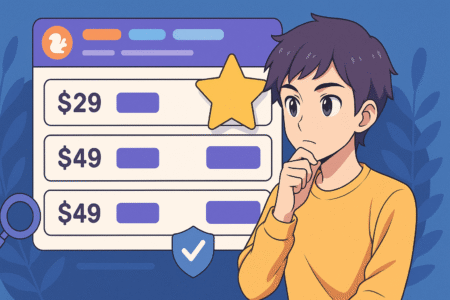
When it comes to choosing the right plan, the real question is: What kind of seller are you? The best value isn’t about just choosing the cheaper option—it’s about picking the tier that fits your strategy.
Free vs. Paid: Which One Matches Your Stage?
If you’re brand new and just curious about product research, the free plan gives you enough of a taste. You’ll get a handful of product examples and see how the dashboard works. But it’s not enough to run real research, and most tools are locked down.
The paid plan is where you can actually work. Full scraper access, daily product curation, and tools like the ad spy and store analyzer make it possible to research and test products quickly. If you’re planning to launch or scale a store, the paid tier is the only real option.
Who Gets the Most Value From the Paid Plan?
The sweet spot for value is probably someone in the early to mid-stage of dropshipping growth. You’re already running a store, or you’re in the build phase and need tools to help you find products faster and outsmart the competition.
This includes:
- Store owners running multiple product tests per week.
- Dropshippers who want to reverse-engineer successful Facebook ads.
- Product researchers looking for unique angles or underserved niches.
If you fall into one of these categories, you’re more likely to extract the full worth of the subscription—especially when using features like handpicked product insights and store analytics to guide your decisions.
When the Plan Might Not Be Worth It
If you’re deep into branded dropshipping or already using enterprise-level tools like AdSpy, Minea, or advanced analytics platforms, Niche Scraper may feel too basic.
Also, if you’re not planning to actively use it each week, you may find the monthly cost too high for casual research. In that case, you might use it just for a month or two during product testing sprints, then cancel once you’ve filled your pipeline.
Tips to Get the Best ROI From Any Tier
To make sure you’re squeezing the most out of what you’re paying, here’s what I suggest:
- Set clear goals before you start—don’t just scroll for hours.
- Use filters and sorting options to narrow down ideas fast.
- Combine insights from multiple tools (like TikTok trends and AliExpress data) with what you find on Niche Scraper.
- Build systems: pick product ideas in batches and create swipe files of ads, stores, and product pages you want to emulate.
The more intentional you are, the faster you’ll see value—and the less likely you’ll feel like you’re wasting your subscription.
Maximize Every Dollar With Smart Niche Scraper Usage Tips
Paying for a tool is one thing—actually getting your money’s worth is another. If you’re already subscribed or seriously thinking about it, here’s how to make Niche Scraper work harder for your business.
Start With a System, Not Just Browsing
It’s easy to fall into the trap of scrolling endlessly through product lists, hoping something jumps out. Instead, set a clear goal before you log in. Ask yourself:
- Are you looking for impulse-buy products under $30?
- Do you want evergreen items with steady demand?
- Are you testing a seasonal trend?
Use Niche Scraper’s filters and tags to narrow your search and avoid wasting time on random scrolling. This approach makes your research more strategic and helps you spot patterns faster.
Use the Handpicked Products Like a Blueprint
One of the most underrated features in Niche Scraper is its curated product list. These aren’t just random picks—they include Facebook ad examples, target audience suggestions, potential profit margins, and even ad copy ideas.
Instead of copying them directly, treat them like templates:
- Study the product angle they’re using (problem-solving, emotional appeal, etc.).
- Look at the price points and ad creatives.
- Note the suggested audience targeting and tweak it for your own tests.
This alone can cut your testing time in half, and you’ll gain a better sense of how winning products are framed and marketed.
Combine Scraper and Store Analysis for Smarter Picks
Don’t just stop at finding a hot product. Once you find something interesting, run the supplier or competitor through the Store Analyzer. You’ll get insights into how much traffic they’re getting, what else they’re selling, and how their site is structured.
It’s a simple way to reverse-engineer what’s working. Maybe they’re bundling products, offering limited-time deals, or using upsells that you can replicate or improve on.
Track What Works and Build a Swipe File
As you discover promising products, build a swipe file—a personal library of products, ads, and pages that inspire you. Use folders or tools like Notion, Google Sheets, or Trello to save:
- Product names and links
- Supplier ratings
- Ad examples with metrics
- Pricing strategies and landing pages
This makes it easier to spot repeatable success patterns and avoid going back to square one every time you test a new product.
Stay Ahead of Saturation With Speed and Variation
Because Niche Scraper is a popular tool, saturation happens fast. That’s why timing and originality matter. If you find a hot product, test it fast—but add your own angle to the ad creative or product description.
Even a small twist (like bundling, rebranding, or targeting a different demographic) can give you a competitive edge.
Discover When to Upgrade or Cancel Your Niche Scraper Plan

Knowing when to level up—or walk away—is just as important as how you use the tool. Let’s break down how to decide if Niche Scraper is still right for your stage of growth.
You’re Ready to Upgrade If You’re Scaling Product Testing
If you’ve moved past testing one or two products and you’re building out full product lines or launching weekly ad campaigns, it’s probably time to go all-in with the paid plan.
You’ll benefit most when:
- You’re testing 5+ products a week.
- You’re spending on ads and need faster product validation.
- You want to analyze competitor stores to fine-tune your funnels.
At this point, the $49.95/month cost is easy to justify because it speeds up decision-making and keeps your test cycles lean and focused.
Consider Downgrading or Canceling If You’re Not Actively Using It
If your dropshipping store is paused, or you’re taking time off to rebuild your strategy, keeping the subscription may not be worth it. Niche Scraper is a great tool, but it’s best used consistently.
You might also cancel temporarily if:
- You’re focusing solely on one product or brand and no longer need product discovery.
- You’ve moved to a more automated or agency-based workflow.
- You prefer niche-specific tools (like ad-focused platforms or email marketing software) at this stage of your business.
Since there’s no penalty for canceling and resubscribing later, don’t hesitate to pause when you’re not getting daily or weekly value from the tool.
Use the Tool in Sprints, Not Constantly
One way to stay efficient is to subscribe in short bursts. Use Niche Scraper intensively for one or two months to build out your product pipeline. Then pause your subscription while you focus on ads, fulfillment, and optimization.
This sprint-based approach is perfect for solo founders or small teams. It keeps your costs down without losing access to the tool’s benefits when you really need them.
Consider Alternatives If Your Goals Change
If you pivot from dropshipping to a branded DTC (direct-to-consumer) model, your needs shift. You might lean more into tools like Google Trends, TikTok Creative Center, or dedicated ad spy tools like Minea or BigSpy.
Niche Scraper is best suited for active product research, Facebook ad strategy, and early-stage ecommerce growth. If that’s no longer your focus, it might be time to graduate to more specialized tools.
Hear What Real Users Say About Niche Scraper Pricing Value
You can dig through landing pages and feature lists all day, but sometimes the best insight comes from hearing how real users feel after spending their own money. That’s where reviews and testimonials can really paint a more honest picture of whether Niche Scraper pricing matches up with its value.
Common Praise: Affordable, Reliable, and Time-Saving
Many users—especially beginners—say that Niche Scraper gives them a solid bang for their buck. It’s often described as a no-fluff, focused tool that doesn’t try to be everything, but delivers well on what it promises: product research.
Here’s what people tend to highlight in positive reviews:
- The curated product picks are useful and well-explained.
- The platform is beginner-friendly and doesn’t require a steep learning curve.
- The price feels fair for solo entrepreneurs or side hustlers getting started.
Some even compare it favorably to more expensive tools that offer fancy dashboards but less practical insight.
The Downsides Users Call Out
It’s not all sunshine, though. Some users share frustrations—most of them not about the pricing itself, but about limitations tied to value.
Here’s what comes up frequently in less favorable reviews:
- Lack of updates in product curation (some feel it gets repetitive).
- The video ad generator feels too basic for paid ad campaigns.
- More advanced dropshippers find the tool a bit too simple over time.
A few users also mention they wish there were more tutorials or onboarding help—especially when using the scraper and ad spy tools to their full potential.
How Niche Scraper Compares in Community Polls and Threads
In dropshipping forums like r/dropship and ecommerce groups on Facebook, Niche Scraper is usually mentioned as a solid mid-tier tool. Not everyone sticks with it long-term, but many use it as a launchpad—subscribing during their product research phase, then moving to more niche-specific tools once they scale.
If you’re looking for social proof, YouTube creators and micro-influencers in the ecommerce space often include Niche Scraper in their toolkit lists. It’s seen as reliable for what it does, and for many users, that’s enough to justify the price.
Weigh the ROI of Niche Scraper for Different User Types
Whether Niche Scraper pricing is “worth it” depends entirely on who you are and where you’re at in your ecommerce journey. Let’s break it down by user type so you can figure out where you fit—and what kind of return you can actually expect.
Solo Entrepreneurs and Side Hustlers
If you’re running your store alone or in your spare time, time and focus are your biggest challenges. Niche Scraper helps you skip the trial-and-error chaos by handing you pre-vetted product ideas and competitor insights.
ROI for this group is typically high if you actively use the tool. Even one winning product found through the platform could recoup several months of subscription fees. The key is staying consistent—logging in, testing products, and using the data to your advantage.
Small Teams and New Agencies
For two- or three-person teams running multiple stores or managing client stores, the tool can become part of a repeatable process. One person can handle scraping, another runs Facebook ads, and a third builds the store. That kind of workflow makes full use of everything Niche Scraper offers.
ROI grows fast here because:
- You can scale product testing more efficiently.
- You save hours on manual research.
- Everyone works from the same curated data.
It’s not enterprise-grade, but it’s ideal for fast-moving, lean ecommerce operations.
Large Ecommerce Stores and Seasoned Marketers
This is where the ROI starts to flatten out. If you’re running six-figure stores or working with a team of analysts, you’ve probably already outgrown what Niche Scraper offers. You might prefer advanced tools like AdSpy, Pexgle, or Minea for deeper ad intelligence and custom analytics.
That said, some high-level users still keep a Niche Scraper subscription handy for inspiration. It’s faster to scroll curated lists and use scraping tools than to build something from scratch every time. The ROI here isn’t in dollars—it’s in convenience and speed.
Newcomers Still Learning Dropshipping
For those just stepping into the ecommerce world, Niche Scraper can either be a great teacher—or a wasted investment. If you’re not willing to learn how to read the data or test products properly, you won’t get value from it.
But if you treat it like a learning tool—exploring store strategies, tracking ad ideas, and studying product angles—it becomes a $49.95/month crash course in what works in the market. That’s a bargain, if you use it right.

